Australian Taxation Law Assignment: Taxable Income Calculation
VerifiedAdded on 2022/08/01
|5
|1331
|20
Homework Assignment
AI Summary
This assignment solution addresses an Australian Taxation Law problem, focusing on calculating an individual's taxable income and tax liability. Part 1 involves determining assessable income from salary, training payments, a gift, and rental income, while also considering the capital gains tax implications from the sale of a rental property. Deductible outgoings, including car expenses, laptop computer expenses, and clothing expenses, are also calculated. Part 2 then calculates the income tax liability and Medicare levy based on the determined taxable income, considering PAYG deductions. The solution applies relevant sections of the ITAA 1997 and tax rulings to justify each calculation, providing a comprehensive breakdown of the tax assessment process.
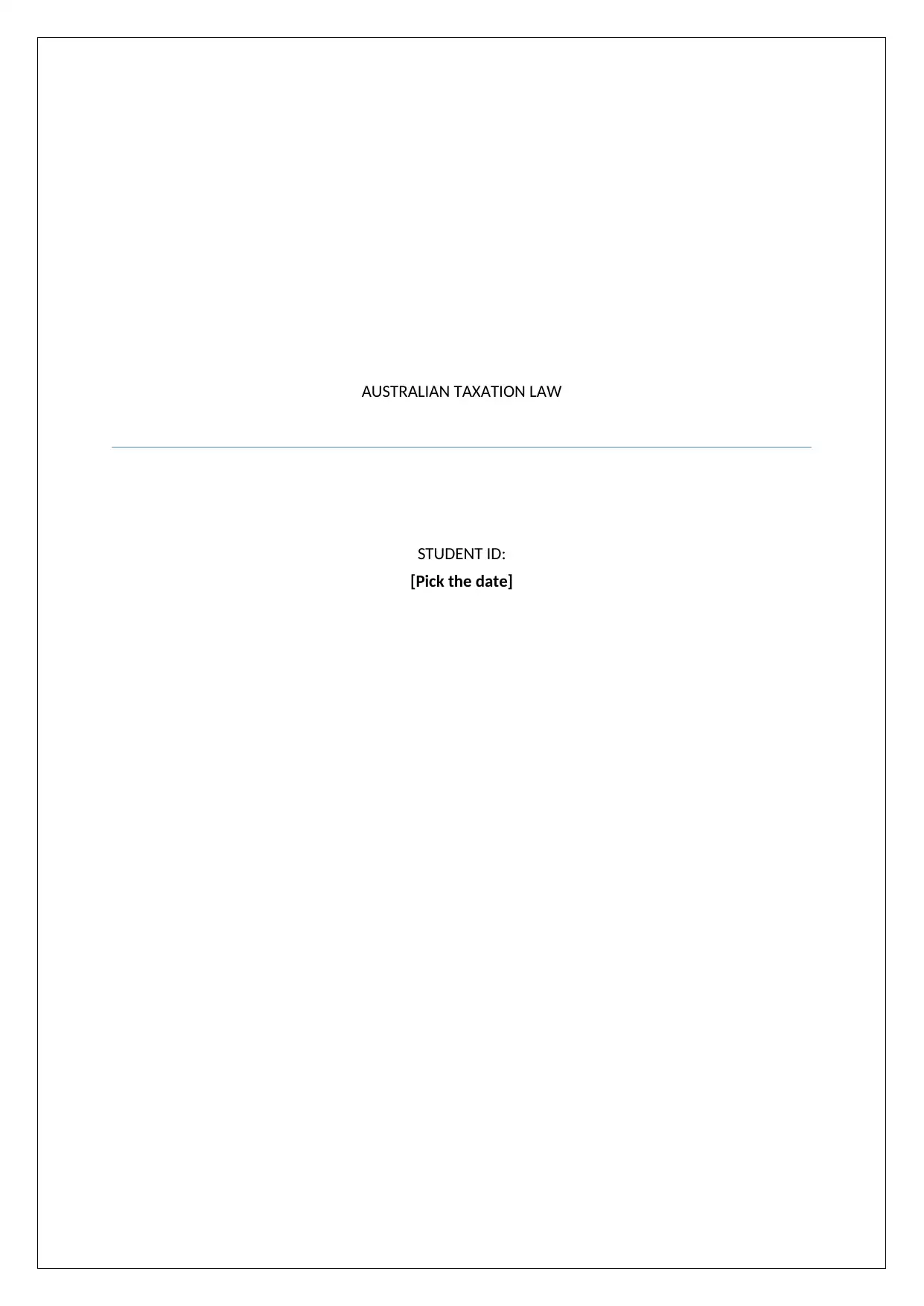
AUSTRALIAN TAXATION LAW
STUDENT ID:
[Pick the date]
STUDENT ID:
[Pick the date]
Paraphrase This Document
Need a fresh take? Get an instant paraphrase of this document with our AI Paraphraser
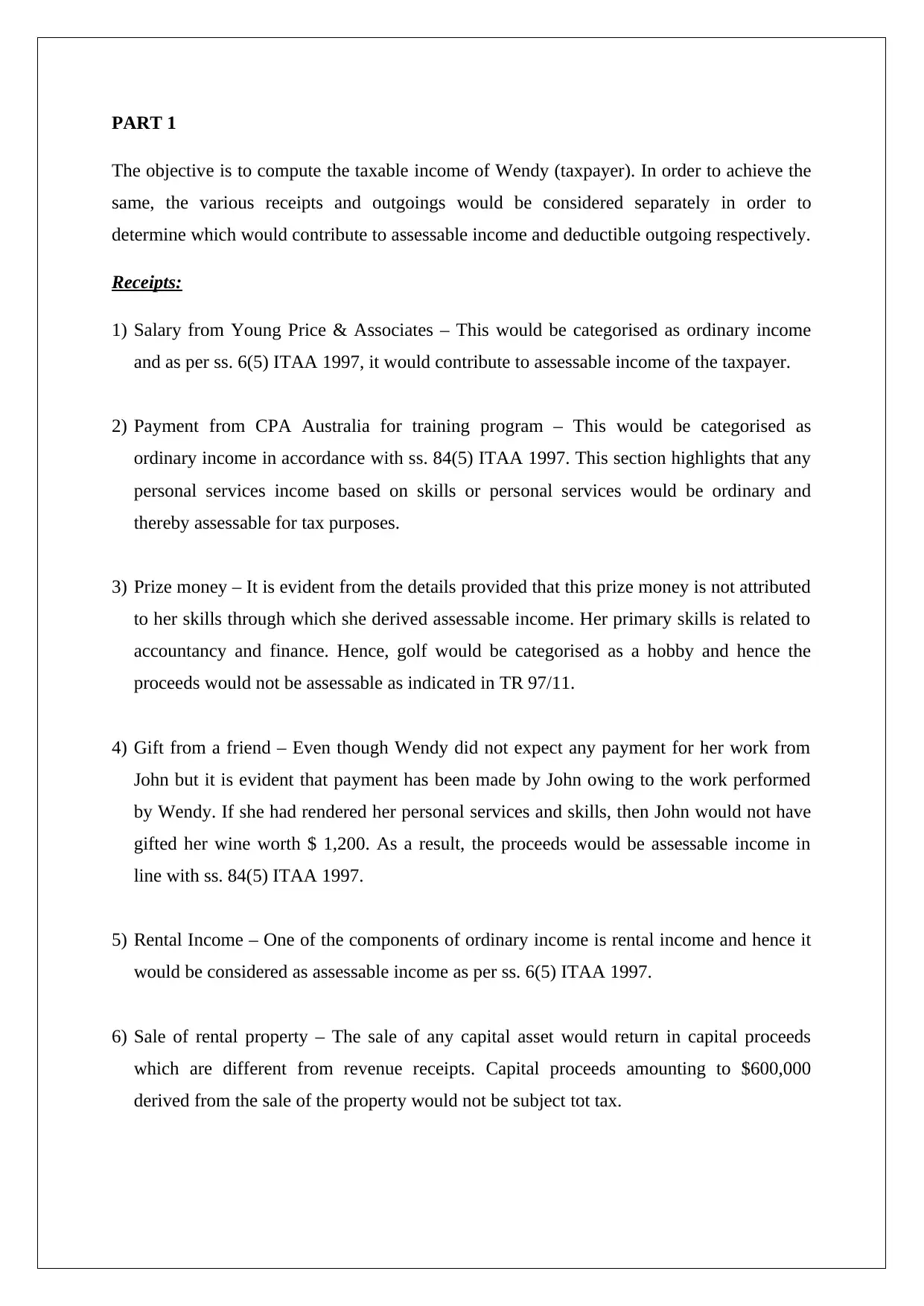
PART 1
The objective is to compute the taxable income of Wendy (taxpayer). In order to achieve the
same, the various receipts and outgoings would be considered separately in order to
determine which would contribute to assessable income and deductible outgoing respectively.
Receipts:
1) Salary from Young Price & Associates – This would be categorised as ordinary income
and as per ss. 6(5) ITAA 1997, it would contribute to assessable income of the taxpayer.
2) Payment from CPA Australia for training program – This would be categorised as
ordinary income in accordance with ss. 84(5) ITAA 1997. This section highlights that any
personal services income based on skills or personal services would be ordinary and
thereby assessable for tax purposes.
3) Prize money – It is evident from the details provided that this prize money is not attributed
to her skills through which she derived assessable income. Her primary skills is related to
accountancy and finance. Hence, golf would be categorised as a hobby and hence the
proceeds would not be assessable as indicated in TR 97/11.
4) Gift from a friend – Even though Wendy did not expect any payment for her work from
John but it is evident that payment has been made by John owing to the work performed
by Wendy. If she had rendered her personal services and skills, then John would not have
gifted her wine worth $ 1,200. As a result, the proceeds would be assessable income in
line with ss. 84(5) ITAA 1997.
5) Rental Income – One of the components of ordinary income is rental income and hence it
would be considered as assessable income as per ss. 6(5) ITAA 1997.
6) Sale of rental property – The sale of any capital asset would return in capital proceeds
which are different from revenue receipts. Capital proceeds amounting to $600,000
derived from the sale of the property would not be subject tot tax.
The objective is to compute the taxable income of Wendy (taxpayer). In order to achieve the
same, the various receipts and outgoings would be considered separately in order to
determine which would contribute to assessable income and deductible outgoing respectively.
Receipts:
1) Salary from Young Price & Associates – This would be categorised as ordinary income
and as per ss. 6(5) ITAA 1997, it would contribute to assessable income of the taxpayer.
2) Payment from CPA Australia for training program – This would be categorised as
ordinary income in accordance with ss. 84(5) ITAA 1997. This section highlights that any
personal services income based on skills or personal services would be ordinary and
thereby assessable for tax purposes.
3) Prize money – It is evident from the details provided that this prize money is not attributed
to her skills through which she derived assessable income. Her primary skills is related to
accountancy and finance. Hence, golf would be categorised as a hobby and hence the
proceeds would not be assessable as indicated in TR 97/11.
4) Gift from a friend – Even though Wendy did not expect any payment for her work from
John but it is evident that payment has been made by John owing to the work performed
by Wendy. If she had rendered her personal services and skills, then John would not have
gifted her wine worth $ 1,200. As a result, the proceeds would be assessable income in
line with ss. 84(5) ITAA 1997.
5) Rental Income – One of the components of ordinary income is rental income and hence it
would be considered as assessable income as per ss. 6(5) ITAA 1997.
6) Sale of rental property – The sale of any capital asset would return in capital proceeds
which are different from revenue receipts. Capital proceeds amounting to $600,000
derived from the sale of the property would not be subject tot tax.
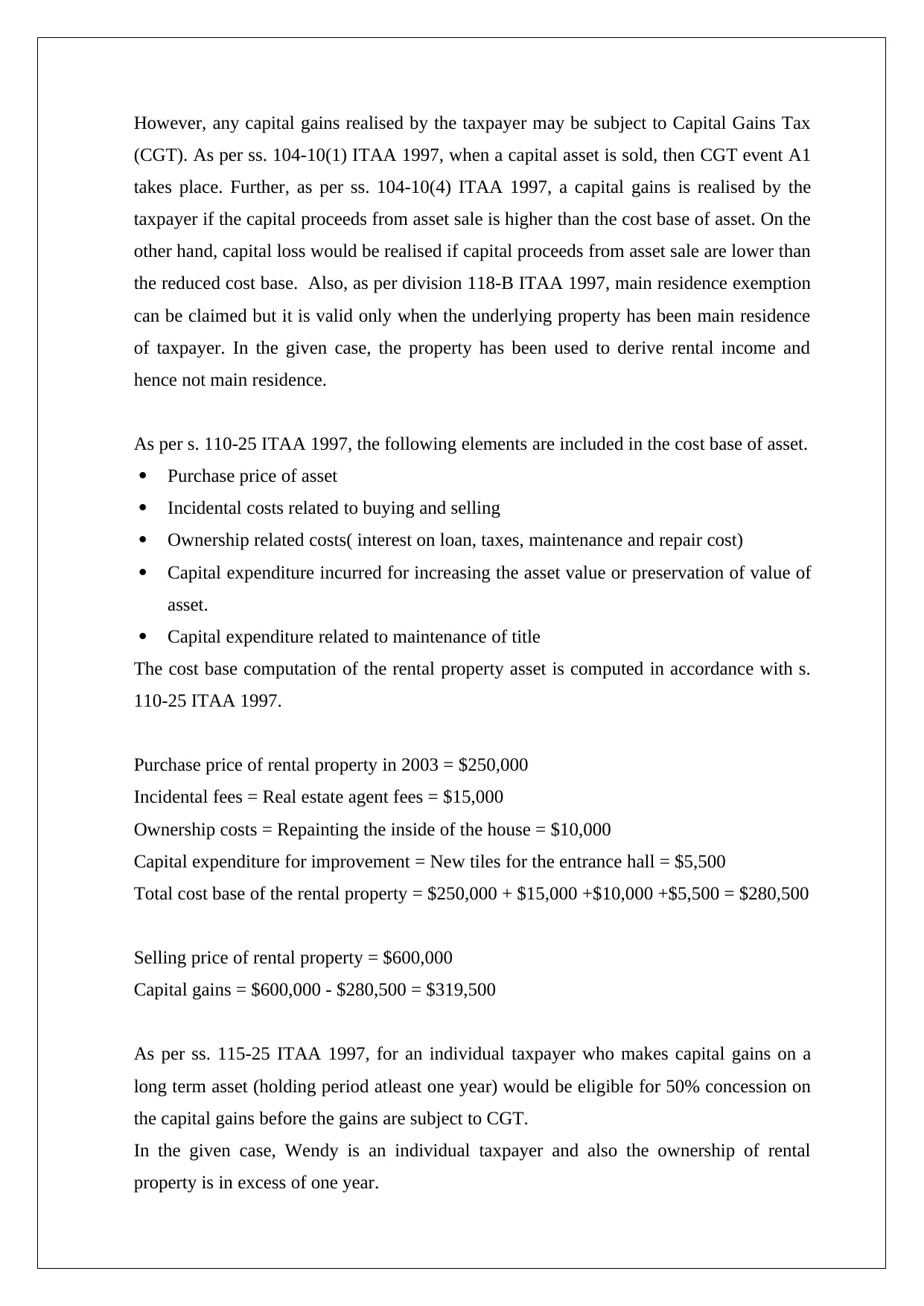
However, any capital gains realised by the taxpayer may be subject to Capital Gains Tax
(CGT). As per ss. 104-10(1) ITAA 1997, when a capital asset is sold, then CGT event A1
takes place. Further, as per ss. 104-10(4) ITAA 1997, a capital gains is realised by the
taxpayer if the capital proceeds from asset sale is higher than the cost base of asset. On the
other hand, capital loss would be realised if capital proceeds from asset sale are lower than
the reduced cost base. Also, as per division 118-B ITAA 1997, main residence exemption
can be claimed but it is valid only when the underlying property has been main residence
of taxpayer. In the given case, the property has been used to derive rental income and
hence not main residence.
As per s. 110-25 ITAA 1997, the following elements are included in the cost base of asset.
Purchase price of asset
Incidental costs related to buying and selling
Ownership related costs( interest on loan, taxes, maintenance and repair cost)
Capital expenditure incurred for increasing the asset value or preservation of value of
asset.
Capital expenditure related to maintenance of title
The cost base computation of the rental property asset is computed in accordance with s.
110-25 ITAA 1997.
Purchase price of rental property in 2003 = $250,000
Incidental fees = Real estate agent fees = $15,000
Ownership costs = Repainting the inside of the house = $10,000
Capital expenditure for improvement = New tiles for the entrance hall = $5,500
Total cost base of the rental property = $250,000 + $15,000 +$10,000 +$5,500 = $280,500
Selling price of rental property = $600,000
Capital gains = $600,000 - $280,500 = $319,500
As per ss. 115-25 ITAA 1997, for an individual taxpayer who makes capital gains on a
long term asset (holding period atleast one year) would be eligible for 50% concession on
the capital gains before the gains are subject to CGT.
In the given case, Wendy is an individual taxpayer and also the ownership of rental
property is in excess of one year.
(CGT). As per ss. 104-10(1) ITAA 1997, when a capital asset is sold, then CGT event A1
takes place. Further, as per ss. 104-10(4) ITAA 1997, a capital gains is realised by the
taxpayer if the capital proceeds from asset sale is higher than the cost base of asset. On the
other hand, capital loss would be realised if capital proceeds from asset sale are lower than
the reduced cost base. Also, as per division 118-B ITAA 1997, main residence exemption
can be claimed but it is valid only when the underlying property has been main residence
of taxpayer. In the given case, the property has been used to derive rental income and
hence not main residence.
As per s. 110-25 ITAA 1997, the following elements are included in the cost base of asset.
Purchase price of asset
Incidental costs related to buying and selling
Ownership related costs( interest on loan, taxes, maintenance and repair cost)
Capital expenditure incurred for increasing the asset value or preservation of value of
asset.
Capital expenditure related to maintenance of title
The cost base computation of the rental property asset is computed in accordance with s.
110-25 ITAA 1997.
Purchase price of rental property in 2003 = $250,000
Incidental fees = Real estate agent fees = $15,000
Ownership costs = Repainting the inside of the house = $10,000
Capital expenditure for improvement = New tiles for the entrance hall = $5,500
Total cost base of the rental property = $250,000 + $15,000 +$10,000 +$5,500 = $280,500
Selling price of rental property = $600,000
Capital gains = $600,000 - $280,500 = $319,500
As per ss. 115-25 ITAA 1997, for an individual taxpayer who makes capital gains on a
long term asset (holding period atleast one year) would be eligible for 50% concession on
the capital gains before the gains are subject to CGT.
In the given case, Wendy is an individual taxpayer and also the ownership of rental
property is in excess of one year.
⊘ This is a preview!⊘
Do you want full access?
Subscribe today to unlock all pages.

Trusted by 1+ million students worldwide
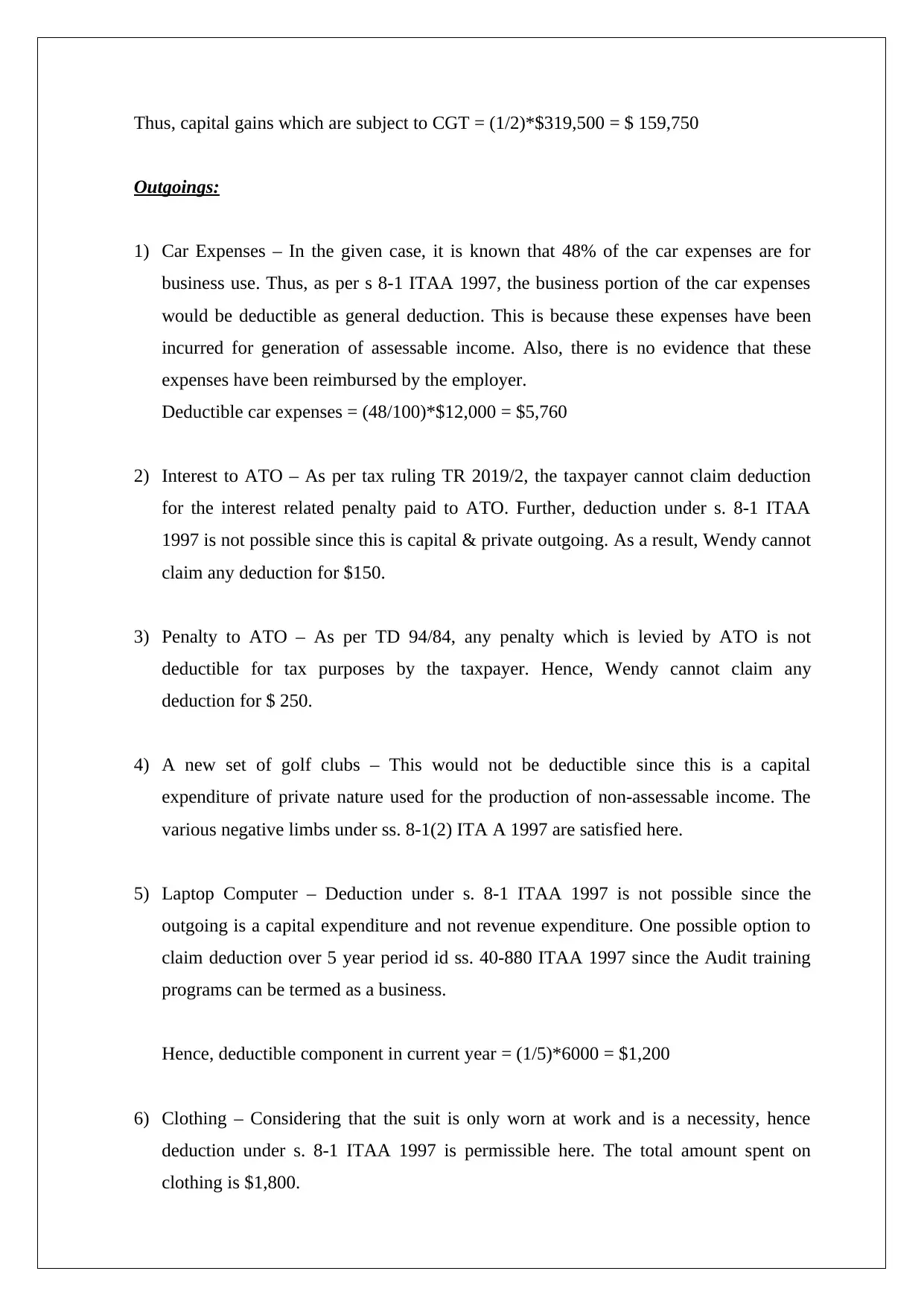
Thus, capital gains which are subject to CGT = (1/2)*$319,500 = $ 159,750
Outgoings:
1) Car Expenses – In the given case, it is known that 48% of the car expenses are for
business use. Thus, as per s 8-1 ITAA 1997, the business portion of the car expenses
would be deductible as general deduction. This is because these expenses have been
incurred for generation of assessable income. Also, there is no evidence that these
expenses have been reimbursed by the employer.
Deductible car expenses = (48/100)*$12,000 = $5,760
2) Interest to ATO – As per tax ruling TR 2019/2, the taxpayer cannot claim deduction
for the interest related penalty paid to ATO. Further, deduction under s. 8-1 ITAA
1997 is not possible since this is capital & private outgoing. As a result, Wendy cannot
claim any deduction for $150.
3) Penalty to ATO – As per TD 94/84, any penalty which is levied by ATO is not
deductible for tax purposes by the taxpayer. Hence, Wendy cannot claim any
deduction for $ 250.
4) A new set of golf clubs – This would not be deductible since this is a capital
expenditure of private nature used for the production of non-assessable income. The
various negative limbs under ss. 8-1(2) ITA A 1997 are satisfied here.
5) Laptop Computer – Deduction under s. 8-1 ITAA 1997 is not possible since the
outgoing is a capital expenditure and not revenue expenditure. One possible option to
claim deduction over 5 year period id ss. 40-880 ITAA 1997 since the Audit training
programs can be termed as a business.
Hence, deductible component in current year = (1/5)*6000 = $1,200
6) Clothing – Considering that the suit is only worn at work and is a necessity, hence
deduction under s. 8-1 ITAA 1997 is permissible here. The total amount spent on
clothing is $1,800.
Outgoings:
1) Car Expenses – In the given case, it is known that 48% of the car expenses are for
business use. Thus, as per s 8-1 ITAA 1997, the business portion of the car expenses
would be deductible as general deduction. This is because these expenses have been
incurred for generation of assessable income. Also, there is no evidence that these
expenses have been reimbursed by the employer.
Deductible car expenses = (48/100)*$12,000 = $5,760
2) Interest to ATO – As per tax ruling TR 2019/2, the taxpayer cannot claim deduction
for the interest related penalty paid to ATO. Further, deduction under s. 8-1 ITAA
1997 is not possible since this is capital & private outgoing. As a result, Wendy cannot
claim any deduction for $150.
3) Penalty to ATO – As per TD 94/84, any penalty which is levied by ATO is not
deductible for tax purposes by the taxpayer. Hence, Wendy cannot claim any
deduction for $ 250.
4) A new set of golf clubs – This would not be deductible since this is a capital
expenditure of private nature used for the production of non-assessable income. The
various negative limbs under ss. 8-1(2) ITA A 1997 are satisfied here.
5) Laptop Computer – Deduction under s. 8-1 ITAA 1997 is not possible since the
outgoing is a capital expenditure and not revenue expenditure. One possible option to
claim deduction over 5 year period id ss. 40-880 ITAA 1997 since the Audit training
programs can be termed as a business.
Hence, deductible component in current year = (1/5)*6000 = $1,200
6) Clothing – Considering that the suit is only worn at work and is a necessity, hence
deduction under s. 8-1 ITAA 1997 is permissible here. The total amount spent on
clothing is $1,800.
Paraphrase This Document
Need a fresh take? Get an instant paraphrase of this document with our AI Paraphraser
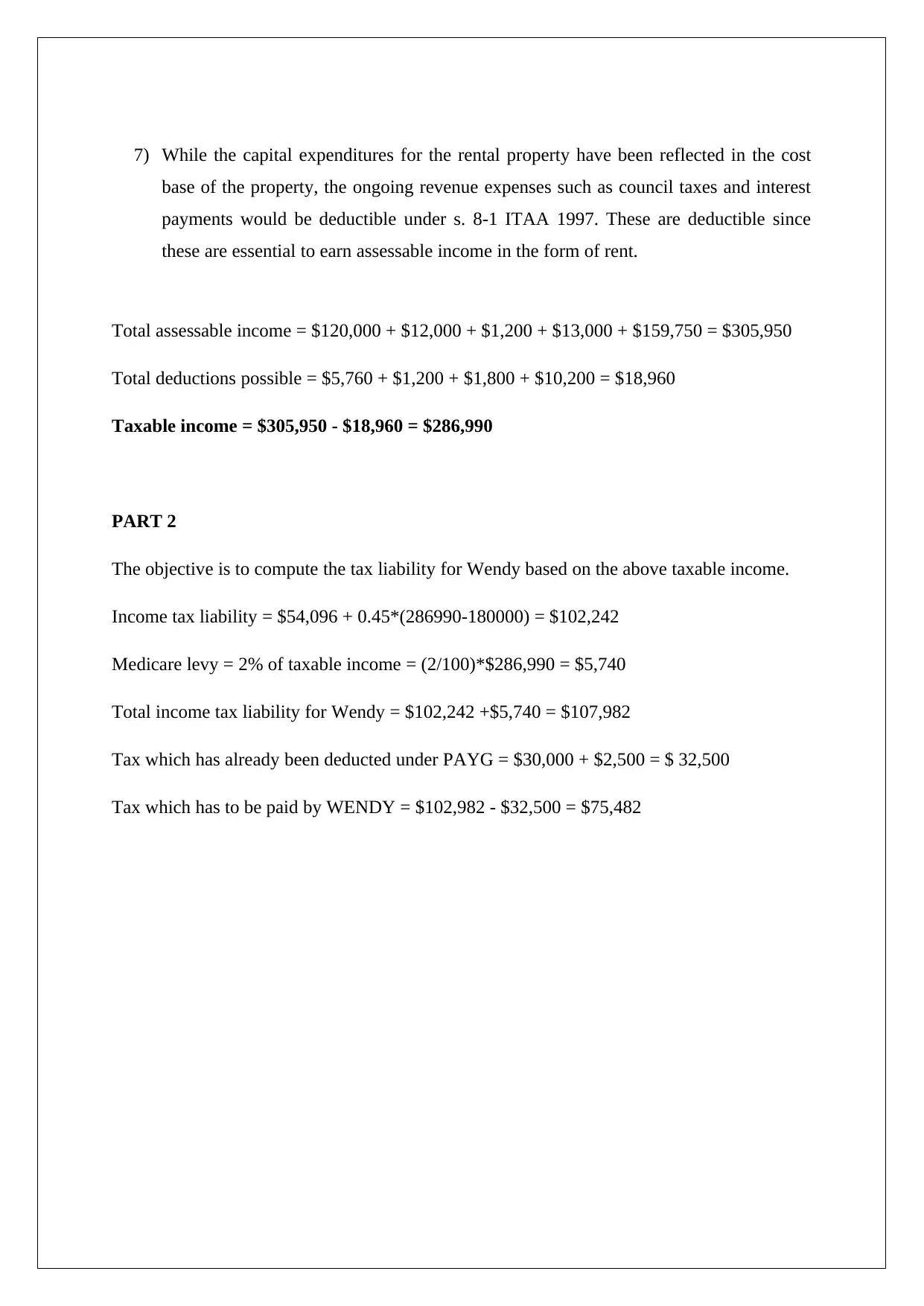
7) While the capital expenditures for the rental property have been reflected in the cost
base of the property, the ongoing revenue expenses such as council taxes and interest
payments would be deductible under s. 8-1 ITAA 1997. These are deductible since
these are essential to earn assessable income in the form of rent.
Total assessable income = $120,000 + $12,000 + $1,200 + $13,000 + $159,750 = $305,950
Total deductions possible = $5,760 + $1,200 + $1,800 + $10,200 = $18,960
Taxable income = $305,950 - $18,960 = $286,990
PART 2
The objective is to compute the tax liability for Wendy based on the above taxable income.
Income tax liability = $54,096 + 0.45*(286990-180000) = $102,242
Medicare levy = 2% of taxable income = (2/100)*$286,990 = $5,740
Total income tax liability for Wendy = $102,242 +$5,740 = $107,982
Tax which has already been deducted under PAYG = $30,000 + $2,500 = $ 32,500
Tax which has to be paid by WENDY = $102,982 - $32,500 = $75,482
base of the property, the ongoing revenue expenses such as council taxes and interest
payments would be deductible under s. 8-1 ITAA 1997. These are deductible since
these are essential to earn assessable income in the form of rent.
Total assessable income = $120,000 + $12,000 + $1,200 + $13,000 + $159,750 = $305,950
Total deductions possible = $5,760 + $1,200 + $1,800 + $10,200 = $18,960
Taxable income = $305,950 - $18,960 = $286,990
PART 2
The objective is to compute the tax liability for Wendy based on the above taxable income.
Income tax liability = $54,096 + 0.45*(286990-180000) = $102,242
Medicare levy = 2% of taxable income = (2/100)*$286,990 = $5,740
Total income tax liability for Wendy = $102,242 +$5,740 = $107,982
Tax which has already been deducted under PAYG = $30,000 + $2,500 = $ 32,500
Tax which has to be paid by WENDY = $102,982 - $32,500 = $75,482
1 out of 5
Related Documents
Your All-in-One AI-Powered Toolkit for Academic Success.
+13062052269
info@desklib.com
Available 24*7 on WhatsApp / Email
![[object Object]](/_next/static/media/star-bottom.7253800d.svg)
Unlock your academic potential
Copyright © 2020–2025 A2Z Services. All Rights Reserved. Developed and managed by ZUCOL.


![Taxation Law: CGT, Deductions, and Exemptions - Student ID [Date]](/_next/image/?url=https%3A%2F%2Fdesklib.com%2Fmedia%2Ftaxation-law-computation-explanations_page_2.jpg&w=256&q=75)


